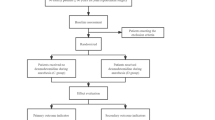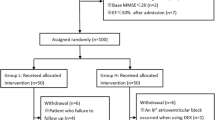Abstract
Background and aims
Postoperative delirium (POD) is a common and serious surgical complication among the elderly, especially in those with amnestic mild cognitive impairment (aMCI). Dexmedetomidine (DEX) is neuroprotective for delirium. In this study, we determined the effect of intravenously administered DEX during general anesthesia on POD in elderly aMCI patients undergoing elective hip joint or knee joint or shoulder joint replacement surgery.
Methods
This was a prospective, randomized parallel-group study of aMCI (n = 80) and normal elderly patients (n = 120). Prior to surgery, all subjects underwent neuropsychological assessment and were assigned to one of four groups: the aMCI DEX group (MD group, n = 40), the aMCI normal saline group (MN group, n = 40), the control DEX group (CD group, n = 60), and the control normal saline group (CN group, n = 60). The confusion assessment method was used to screen POD on postoperative days 1, 3, and 7.
Results
We found patients age was positively correlated with POD incidence in the MN group (p < 0.05) but not in the CN group (p < 0.05). DEX treatment significantly decreased POD incidence in both control and aMCI groups relative to their respective placebo groups (all p < 0.05). The fraction of patients whose normal cognitive function was not restored by day 7 after surgery was significantly higher in the MN group than the MD and CN groups (all p < 0.05).
Conclusions
These findings suggested that DEX treatment during surgery significantly reduced POD incidence in both normal and aMCI elderly patients, suggesting that it may be an effective option for the prevention of POD.

Similar content being viewed by others
References
Olofsson B, Lundström M, Borssén B et al (2005) Delirium is associated with poor rehabilitation outcome in elderly patients treated for femoral neck fractures. Scand J Caring Sci 19:119–127
Rooney S, Qadir M, Adamis D et al (2014) Diagnostic and treatment practices of delirium in a general hospital. Aging Clin Exp Res 26:625–633
Inouye SK (2006) Delirium in older persons. N Engl J Med 354:1157–1165
Demeure MJ, Fain MJ (2006) The elderly surgical patient and postoperative delirium. J Am Coll Surg 203:752–757
Mazzola P, Bellelli G, Broggini V et al (2015) Postoperative delirium and pre-fracture disability predict 6-month mortality among the oldest old hip fracture patients. Aging Clin Exp Res 27:53–60
American Psychiatric Association (1994) Diagnostic and statistical manual of mental disorders (DSM-IV). APA, Washington
Van der Mast RC, van den Broek WW, Fekkes D et al (1999) Incidence of and preoperative predictors for delirium after cardiac surgery. J Psychosom Res 46:479–483
Breteler MM, Claus JJ, Grobbee DE et al (1994) Cardiovascular disease and distribution of cognitive function in elderly people: the Rotterdam Study. BMJ 308:1604–1608
Gustafson Y, Berggren D, Brännström B et al (1988) Acute confusional states in elderly patients treated for femoral neck fracture. J Am Geriatr Soc 36:525–530
Brannstrom B, Gustafson Y, Norberg A et al (1989) Problems of basic nursing care in acutely confused and non-confused hip-fracture patients. Scand J Caring Sci 3:27–34
Marcantonio ER, Flacker JM, Michaels M et al (2000) Delirium is independently associated with poor functional recovery after hip fracture. J Am Geriatr Soc 48:618–624
Berggren D, Gustafson Y, Eriksson B et al (1987) Postoperative confusion after an-esthesia in elderly patients with femoral neck fractures. Anesth Analg 66:497–504
Rahkonen T, Luukkainen-Markkula R, Paanila S et al (2000) Delirium episode as a sign of undetected dementia among community dwelling elderly subjects: a 2 year follow up study. J Neurol Neurosurg Psychiatry 69:519–521
Evered LA, Silbert BS, Scott DA et al (2011) Preexisting cognitive impairment and mild cognitive impairment in subjects presenting for total hip joint replacement. Anesthesiology 114:1297–1304
Veliz-Reissmüller G, Agüero Torres H, Van der Linden J et al (2007) Pre-operative mild cognitive dysfunction predicts risk for post-operative delirium after elective cardiac surgery. Aging Clin Exp Res 19:172–177
Panza F, D’Introno A, Colacicco AM et al (2005) Current epidemiology of mild cognitive impairment and other predementia syndromes. Am J Geriatr Psychiatry 13:633–644
Forlenza OV, Diniz BS, Gattaz WF (2010) Diagnosis and biomarkers of predementia in Alzheimer’s disease. BMC Med 8:89
Welge-Lüssen A (2009) Ageing, neurodegeneration, and olfactory and gustatory loss. B-ENT 5(suppl 13):129–132
Markesbery WR, Schmitt FA, Kryscio RJ et al (2000) Neuropathologic substrate of mild cognitive impairment. Arch Neurol 63:38–46
Bhana N, Goa KL, McClellan KJ (2000) Dexmedetomidine. Drugs 59:263–268
Candiotti KA, Bergese SD, Bokesch PM et al (2000) Monitored anesthesia care with dexmedetomidine: a prospective, randomized, double-blind, multicenter trial. Anesth Analg 110:47–56
Cooper L, Candiotti K, Gallagher C et al (2011) A randomized, controlled trial on dexmedetomidine for providing adequate sedation and hemodynamic control for awake, diagnostic transesophageal echocardiography. J Cardiothorac Vasc Anesth 25:233–237
Yang S, Lee H (2014) A dose-finding study of preoperative intravenous dexmedetomidine in children’s emergence delirium after epiblepharon surgery. Eur J Ophthalmol 24:417–423
Bekker A, Haile M, Kline R et al (2013) The effect of intraoperative infusion of dexmedetomidine on the quality of recovery after major spinal surgery. J Neurosurg Anesthesiol 25:16–24
Zhang X, Wang J, Qian W et al (2014) Dexmedetomidine inhibits tumor necrosis factor-alpha and interleukin 6 in lipopolysaccharide-stimulated astrocytes by suppression of c-Jun N-terminal kinases. Inflammation 37:942–949
Zhang Y, Xing Z, Xu Y et al (2014) Effects of different doses of dexmedetomidine on cognitive dysfunction in elderly patients early after laparoscopic surgery for colorectal cancer. Nan Fang Yi Ke Da Xue Xue Bao 34:743–746
Shehabi Y, Grant P, Wolfenden H et al (2009) Prevalence of delirium with dexmedetomidine compared with morphine based therapy after cardiac surgery: a randomized controlled trial (dexmedetomidine compared to morphine-DEXCOM study). Anesthesiology 111:1075–1084
Chen J, Yan J, Han X (2013) Dexmedetomidine may benefit cognitive function after laparoscopic cholecystectomy in elderly patients. Exp Ther Med 5:489–494
Liu Y, Pan N, Ma Y et al (2013) Inhaled sevoflurane may promote progression of amnestic mild cognitive impairment: a prospective, randomized parallel-group study. Am J Med Sci 345:355–360
Inouye SK, van Dyck CH, Alessi CA et al (1990) Clarifying confusion: the confusion assessment method. A new method for detection of delirium. Ann Intern Med 113:941–948
Bickel H, Gradinger R, Kochs E et al (2008) High risk of cognitive and functional decline after postoperative delirium: a three-year prospective study. Dement Geriatr Cogn Disord 26:26–31
Lundstrom M, Edlund A, Bucht G et al (2003) Dementia after delirium in patients with femoral neck fractures. J Am Geriatr Soc 51:1002–1006
Koppel J (2005) Memory impairment, but not cerebrovascular disease, predicts progression of MCI to dementia. Neurology 64:766
Xie Z, Tanzi RE (2006) Alzheimer’s disease and post-operative cognitive dysfunction. Exp Gerontol 41:346–359
Levkoff SE, Evans DA, Liptzin B et al (1992) Delirium: the occurrence and persistence of symptoms among elderly hospitalized patients. Arch Intern Med 152:334–340
Murray AM, Levkoff SE, Wetle TT et al (1993) Acute delirium and functional decline in the hospitalized elderly patient. J Gerontol 48:M181–M186
Morrison RS, Magaziner J, Gilbert M et al (2003) Relationship between pain and opioid analgesics on the development of delirium following hip fracture. J Gerontol A Biol Sci Med Sci 58:76–81
Pasin L, Landoni G, Nardelli P et al (2014) Dexmedetomidine reduces the risk of delirium, agitation and confusion in critically ill patients: a meta-analysis of randomized controlled trials. J Cardiothorac Vasc Anesth 28:1459–1466
Haan MN, Shemanski L, Jagust WJ et al (1999) The role of APOE epsilon 4 in modulating effects of other risk factors for cognitive decline in elderly persons. JAMA 282:40–46
Qian XL, Zhang W, Liu MZ et al (2015) Dexmedetomidine improves early postoperative cognitive dysfunction in aged mice. Eur J Pharmacol 746:206–212
Pasin L, Greco T, Feltracco P (2013) Dexmedetomidine as a sedative agent in critically ill patients: a meta-analysis of randomized controlled trials. PLoS One 8:e82913
Mo Y, Zimmermann AE (2013) Role of dexmedetomidine for the prevention and treatment of delirium in intensive care unit patients. Ann Pharmacother 47:869–876
Author information
Authors and Affiliations
Corresponding author
Ethics declarations
Conflict of interest
The authors declare that they have no conflict of interest.
Ethical approval
All procedures performed in studies involving human participants were in accordance with the ethical standards of the institutional and/or national research committee and with the 1964 Helsinki declaration and its later amendments or comparable ethical standards.
Informed consent
Informed consent was obtained from all individual participants included in the study.
Rights and permissions
About this article
Cite this article
Liu, Y., Ma, L., Gao, M. et al. Dexmedetomidine reduces postoperative delirium after joint replacement in elderly patients with mild cognitive impairment. Aging Clin Exp Res 28, 729–736 (2016). https://doi.org/10.1007/s40520-015-0492-3
Received:
Accepted:
Published:
Issue Date:
DOI: https://doi.org/10.1007/s40520-015-0492-3




